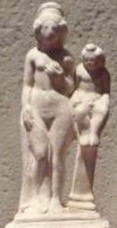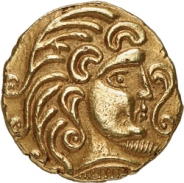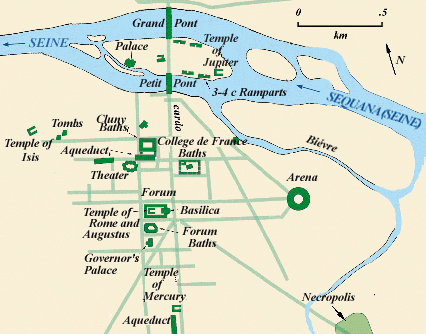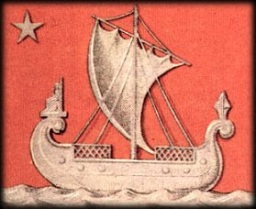In honor of Notre Dame de Paris (“Our Lady of Paris”), and in the expectation that She will indeed rise again in beauty, I offer this post on Our Lady’s extensive connections with the ancient city of Paris.
If you’ve read Isiac lore broadly, you’ve probably come across the idea that the city of Paris is named for Isis, presumably from Per- (the Egyptian word for “house” or “temple”) or Par- (French for “with”) and Her name, Isis. We find that notion in places like Dan Brown’s The DaVinci Code and before him in David Wood’s 1986 book GenIsis: First Book of Revelations and before that in the musings of 17th century amateur “orientalists.”
Unfortunately, it ain’t so.

The name of France’s capital city comes from the Gaulish Parisii clan who had a settlement on what would become the Isle de la Cité, and along the banks of the Seine, starting about 250 BCE. They may have called it something like Lucotocia, possibly from the Celtic word for “marsh.” When Rome conquered them, the Romans built a military base there called Lutetia Parisiorum (“Lutetia of the Parisii”), which eventually got shortened to Paris. Interestingly, there is single mention (in Ptolemy’s Geographica) of a Parisii clan in Yorkshire, England as well, and scholars have speculated whether the Yorkshire Parisii were connected to the Seine Parisii. What’s more, while no one is entirely sure what the name Parisii means, some Celticists think it could come from proto-Celtic words meaning, “commanders,” or perhaps, “fighters,” or—my personal favorite— “they of the cauldrons.”

It is very, very highly unlikely that the “-isii” part of the Parisii tribal name has anything to do with Isis—even in the face of quite a bit of wild-eyed speculation to the contrary; speculation that actually started hundreds of years ago and has grown exponentially of late as things get uncritically replicated across the interwebs.

Nevertheless, is it quite true that Isis does have a long history in France—and with the city of Paris. Isis came to Gaul with the Romans, in the same way that Her worship spread throughout the Roman Empire. So yes indeed, there were shrines and temples to Isis in France. This map shows the supposed location of a Roman Temple of Isis, at or near what is today the abbey of St. Germain des Prés in Paris. It is here, rather than at Notre Dame*, that we have the best hope of finding a lingering tradition of Isis’ presence even quite late.
A writer called Jacques le Grant, or Jacques leGrand, writing about the 1400s, recorded this Isis-Paris connection, tracing it to the 8th century CE:
In the days of Charlemagne [8th century] . . . there was a city named Iseos, so named because of the goddess Isis who was venerated there. Now it is called Melun. [Melun is about an hour south of Paris.] Paris owes its name to the same circumstances, Parisius is said to be similar to Iseos, because it is located on the River Seine in the same manner as Melun.

Le Grant’s reference probably comes from a poem about the siege of Paris by the Normans, written in 886 or 887 CE by a monk named Arbon, who had actually witnessed the siege. In it, Arbon supposedly mentions the veneration of Isis at Melun in his time (!). (I say ‘supposedly’ for I have not seen this poem myself so must withhold judgment.)
In a manuscript from about the same time, now in the French Bibliotheque Nationale, we see Isis, dressed as a Medieval woman, alighting in Paris from a ship with the caption, “Here is seen the very ancient Isis, Goddess and queen of the Egyptians.” Apparently, as in this manuscript, Isis’ association with ships and sailing—think Isis Pelagia and Isis Pharia—was one of the reasons the French connected Her with Paris; one of the city’s symbols is a boat, due to the boatlike shape of the Isle de la Cité (where the Parisii were centered), in the middle of the Seine, in the heart of Paris.
Whether or not this is true is not the point. The point is that the city’s closeness with Isis is part of its lore.

As shown on the map above, some say that a Roman Temple of Isis used to stand in the vicinity of what is today the abbey of St. Germain des Prés. A number of French historians in the 1500s repeated that tradition. And, of course, it was common for churches to be constructed on top of Pagan temples; indeed, it was policy. But I haven’t yet been able to find out whether the St. Germain des Prés tradition is based on archeology or simply on historical references. If you have an archeological source, please tip me off.
However, in texts, we do have an “Issy” associated with the site of the St. Germain complex. Sometime in the 500s, Childebert I, the Frankish king of Paris, gave his estate, Issy, to found a monastery on the site that would eventually become St. Germain des Prés. Scholars think the name “Issy” comes from Medieval Latin Isciacum, probably meaning “estate of Isicius,” a Gallo-Roman landowner. Isicius was most certainly named for the Goddess.

Is this perhaps the Isis Who stands behind the tradition of a Temple of Isis beneath St. Germain? Writing in the early 1600s, Jacques de Breul, a monk actually from St. Germain des Prés, repeated the tradition that the name Issy came from Isis—which it ultimately did if the Isiacum conjecture is correct—but it doesn’t necessarily confirm the existence of a temple on the spot.
Another St. Germain “Isis sighting” I’m trying to track down is the story that, in 1514, the Archbishop of Meaux had a statue—which looked for all the world like the Christian Madonna and Child—removed from St. Germain des Prés and destroyed.
Update: So the story I’ve found so far is stranger than just “destroyed.” Where I’ve tracked the tale so far is to a footnote in a 1685 translation of The Inestimable Life of the Great Gargantua, Father of Pantagruel by François Rabelais. This particular footnote was the work of one of the many commentators/translators on the French work…which I shall not bother you with relating. But you can dig through it yourself if you are so inclined here.
Anyway. Here’s a paraphrase of the footnote because there’s a bit of weirdness in the translation and I think it will be more comprehensible if I paraphrase:
First of all, the footnote says that Isis is believed to have been the tutelary Deity of the Parisians “when they were in the state of Paganism.” (Starts well, no?) Then it proceeds to say that the “idol” they had consecrated to Her was “still subsisting, and in good condition” in the abbey of St. Gemain des Près as of the beginning of the 16th century. However, the note goes on to say, in 1514, it was taken away by order of Guillaume Briçonnet, Bishop of Meaux and Abbot of St. Germain, who put up a red cross in the room where it had been. Even then, the image was not destroyed. “As for the idol, her statue, which was tall and erect, rough and discolored with age,” it was placed against the wall on the north side, where the crucifix of the church stands, “and it was naked, except some drapery in a certain place of two.”
Well. So, not destroyed, but kept? Interesting. What’s more, I kinda think the storyteller here may be telling stories. There were no Isis images “naked, except some drapery in a certain place or two.” Aphrodite, perhaps. But I seriously doubt an image like that would have ended up in a church. It seems to me more like an ever-so-pagan fantasy of the old gentlemen of the 16th century. (Those of you who have been following along have, no doubt, seen several of my rants about the old gentlemen of the 19th century.)
What did that Archbishop think he knew? I’ve ordered a book with the references. I’ll let you know what discover once I check it out. (See above.)

Isis had Her place in the French Revolution as well. As part of the celebrations commemorating the anniversary of the Revolution, in 1793, the Parisians built a huge image of Isis, symbolizing Nature and Regeneration, in the form of a fountain with water pouring from Her breasts. Both politicians and populace came to drink of the water of the Goddess and be renewed. The fountain was—quel dommage!—only temporary. As it was made of bronze-painted plaster, it no longer exists.

The demise of the Revolution did not mean the end of Isis’ French connection. It remained so prevalent that Napoleon—who had developed a severe case of Egyptomania following his Egyptian expedition in 1799—had it checked out by his own scholar. Apparently he was sufficiently convinced that he had a Parisian Coat of Arms designed that included an enthroned Isis on the prow of the “Ship of Paris,” which was shown following the Goddess’ sacred star.
(Much of this has been collected by Robert Bauval and Graham Hancock in their book, Talisman. It’s an older publication, but I just ordered a copy. I suspect I may reach different conclusions than the authors did, but I do appreciate the work they did in collecting the pieces of the tradition and I will definitely be following up on the references.)
Isis is also to be found deeply embedded in the occult traditions of Paris, but that’s a topic too big to get into in one post. Here are links to some Isis connections from the early 20th century with two of my favorite occultists: MacGregor and Moina Mathers.

Yet for now, let’s turn our attention toward the Arts of the period, for She is very much found there as well.
There we meet Gérard de Nerval, French Romantic poet, Symbolist hero, and proto-Surrealist, and a person who did much thinking on the Divine Feminine.
As was so often true —especially for the artists, writers, and occultists who were clearly sharing ideas during this period—for Nerval, one of the most important forms the Divine Feminine takes is Isis. Nerval is a mad poet; literally. He seemed to have suffered from depression and probably schizophrenia. He believed that dreams were the true reality, which is why he was so inspired the Surrealists, but sometimes he had trouble sorting out dream from waking state. He also had some charming and well-known quirks. For instance, he kept a pet lobster, which he took for walks in the park leading it by a blue, satin ribbon, and declaring it a better pet than a dog for it never barked and knew the secrets of the deeps.

Nerval wrote poems and prose, including a piece called “Isis” (1845). It appears in a collection of short prose entitled Les Filles du Feu, the “Girls of Fire.” Isis is the only Goddess among the fiery girls, though Nerval wrote poems about other Pagan Goddesses and Gods as well. “Isis” is more journalistic than poetic. Nerval writes about a party held by an ambassador in Naples. It was a costumed ball in which the life of ancient Pompeii was evoked, including the sunset rites at the Temple of Isis, which Nerval found to be the most inspiring events of the evening.
Nerval describes the temple and the “secret” rites held therein, all the while comparing them and Isis with Christian rites and Mary. This discussion then serves as a launching pad for Nerval to write about Apuleius’ tale of initiation into the Mysteries of Isis. You can feel his yearning as he describes the yearning of Lucius for Isis.
Indeed Nerval spent most of his life longing for feminine love, both human and Divine. Eventually, he could no longer function in the world, his mental illness incapacitating him. He committed suicide just ten years after he wrote “Isis”.
Sometimes we might wonder how it is that Isis, unlike so many of our ancient Goddesses, was never forgotten. From the time She was first recognized in ancient Egypt to now, Isis has never been completely out of human consciousness. Anytime we start pulling on an Isis thread—lore about ancient Isis temples in Paris or Fiery Girls Who take up residence in a mad poet’s dreams—we keep on discovering Her. For me, these discoveries, while always delightful, are no longer surprising. She is always there because She has always been there. She could not be forgotten because She is.

*Notre Dame is not the site of an ancient temple of Isis. There is a crypt beneath the Notre Dame plaza that you can go into and see the archeological remains, all the way back to the Roman ones. For a long time, people thought that there may have been a Jupiter temple there due to the discovery of a large Roman column dedicated to Jupiter by the guild of boatmen in the 1st century CE. It has both Roman and Celtic Deities on it and is the oldest monument in Paris. Today, scholars have evidence to think that the pillar was moved from the Left Bank to the Isle de la Cité…so the question of whether the island was home to any Pagan temple remains unanswered.



